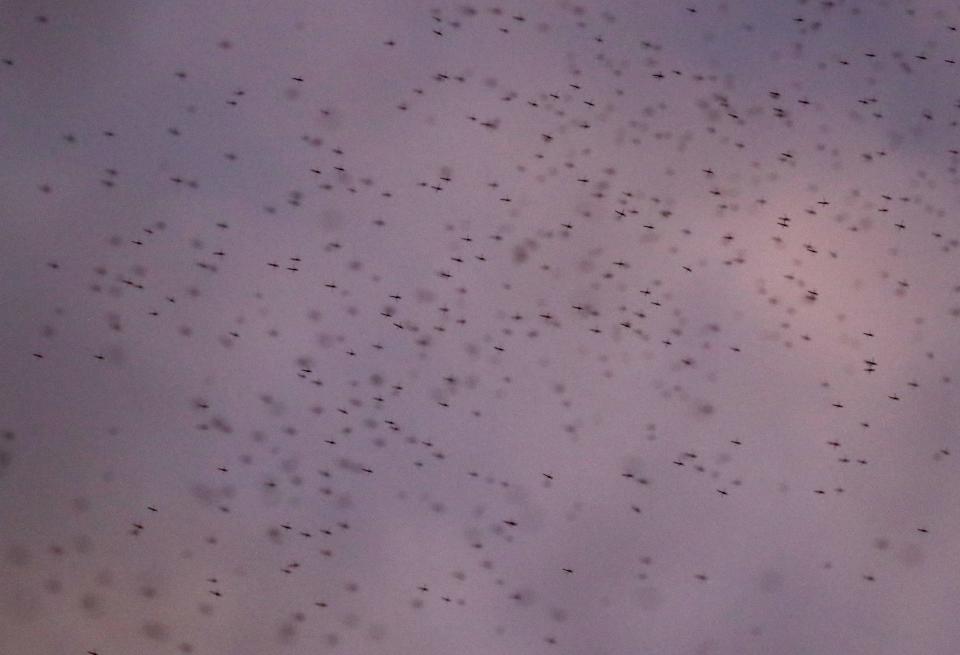Swarming midge flies are taking over Lake Michigan right now
If you've gone out for a walk or run on the paths near Milwaukee's Lake Michigan beaches in the past few weeks, it was likely interrupted by swarms of tiny, black insects.
Often mistaken for mosquitoes, these bugs are actually midge flies, sometimes also called "lake flies." The harmless creatures are a popular type of bait for fishermen and an important food source for animals in the lake ecosystem.
However, as any outdoor enthusiast who's taken a midge (or a few dozen) to the eye or mouth knows, these bugs can be quite overwhelming and annoying for humans.
Here's what to know about these insects.
What are midge flies?
Midge flies are multiple species of minuscule, non-mosquito flies with one pair of long, narrow wings, and long, skinny legs. They are only about 2 to 4 millimeters in size.
They can be found near a wide range of water bodies, including lakes, rivers and retention ponds. Additionally, the insects emerge in a variety of environments, including urban and suburban, as they are resistant to pollution and other adverse conditions.
Why are there so many midge flies by Lake Michigan right now?
Every spring, as temperatures rise, midge flies emerge to look for mates, procreate and lay their eggs in Lake Michigan before dying after, at most, just a few weeks. They begin emerging in huge swarms in April and are at their worst in May, according to the UW-Madison Center for Limnology.
In some areas of the state, "from a distance, they can actually look like plumes of smoke because there are so many, probably tens or hundreds of thousands, in some of these mating swarms that they form," said P.J. Liesch, director of the UW-Madison Insect Diagnostic Lab.
Midges lead a largely unremarkable four-part life cycle. Most of it is spent in the lake as eggs and larvae. But, their short time above water is probably the most exciting. During the spring's first warm weather, mature midges emerge from the lake; males form swarms and females fly in to reproduce.
Females then return to the lake and lay their eggs on the water's surface. The eggs sink to the bottom where they develop into new generations. Each egg mass can contain over 1,000 eggs. After hatching, larvae burrow into the mud and grow for 2 to 7 weeks, depending on the water temperature, NC State Extension explains.
Larvae then transform into pupae, which swim to the surface and emerge as adult midges ready to mate. Their adult life is pretty short, usually less than a week.
During the summer, the midges' entire life cycle can be completed in just a few weeks. Meanwhile, in the fall, larvae do not develop into pupae as quickly; they spend the winter months underwater before maturing in the spring.

Are midge flies dangerous to humans?
Although they can be incredibly annoying, midge flies do not bite, sting or cause disease, Liesch said. Adult midges typically feed on nectar and other sugary materials.
Still, they often land on people's skin and can make their way into your eyes or nose or be inhaled. Gross ... but the good news is, all of this is irritating but not dangerous.
Is there anything good about midge flies?
Midges are an ample food source for ducks, bats, insect-eating birds and small fish like minnows and baby perch, salmon and trout.
"They're major sources of food both for insect-eating birds and in the lake," Martin Berg, a midge expert and professor of biology at Loyola University in Chicago, told the Journal Sentinel. "A lot of fish rely on midges earlier in their life. They're by far the most numerous insect in most aquatic systems."
When will the midge flies go away?
Midge flies can be active throughout the warmer months, Liesch said. But, in Milwaukee, historical patterns have shown a lot of activity in April and May that tapers off to an extent by the summer.
"They will be just a temporary issue," Liesch said. "They're going to be out and very abundant for a short period of time. They will run their course, and then their numbers will decline after a few weeks."
This article originally appeared on Milwaukee Journal Sentinel: Why are there so many flies by Lake Michigan in Milwaukee right now?

